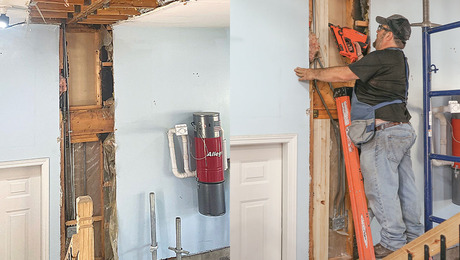My 11 year old house is located in the Pacific Northwest – on the wet side – needs repainting for the 3rd time. I worked for a painting contractor when in school and thought I knew something about preparation and good painting techniques, but I’m clearly doing something wrong. I’ve always used the best quality paint, first time Sherwin Williams and the last Benjamin Moore.
My main problems are failing paint on wood window trim and the Southwest exposed cedar siding. Earlier this year I had to replace two windows who’s wood frames had completely rotted through.
I’m interested in comments on two points – the success of the epoxy restoration products to consolidate and build up damaged wood trim, including ability to hold oil based primer and latex finish; and the advisability, after thorough bleach/TSP cleaning/power wash and needed scrapping, to do a two coat job – a complete re-prime and finish vs. just touch up prime and finish coat. I think I’ve read somewhere that a primer has better sticking capability than finish paint over old paint.
I’m not into complete paint stripping – I think I’d burn it first.
Any advice appreciated.















Replies
If you're on the fourth paint job (original plus three more) in just eleven years, then you should start to investigate why so much moisture is pushing the paint off, and causing the rot.
Even in the most humid locations, a properly built house does not rot in the first decade.
Unless you're the lead dog, the view just never changes.
Got a match?
Sorry.
It seems to me that when cedar has been painted twice already in eleven years and it still rots pout, that something else is wrong - guit instinct with no clues from here.
Paint is made of carrier (watrer or oil) pigment (the colur solids) and glue ( the PVA that gives it adhesion is pretty much the same as white school glue)
Primer does have more glue and less pigment than finish coats.
That's the simple version.
Welcome to the
Taunton University of Knowledge FHB Campus at Breaktime.
where ...
Excellence is its own reward!
Thanks for the commments.
Clarification - cedar siding is not rotting. The rotten part is pine wood window frames. When I removed two last fall and adjoining siding to replace the entire window, the sheathing, vapor barrer and framing were all were all perfectly dry, no evidence of water penetration or leakage. They rotted from the exterior. I highly suspect the inferior quality of soft pine used in the manufacture of the window, but they are a name brand, Oregon manufacturer and not cheap.
The siding is not rotting, just not able to go more than two years before it shows sign of deteriorating paint, fading color, cracking and pealing. I've looked and have no evidence of any water damage or moisture, its not a super tight house, has adequate ventilation and exhaust fans always used, not extremely cold winters causing in-wall condensation, roof is tight, roof, wall and window flashing is right and in good condition, caulking kept repaired and filled, siding not buckling or curling in the summer hot dry weather, just no apparent interior water/moisture problems found.
Siding is rough 6 in. bevel, clear, no knots. It was not back painted. The problem side is the Southest facing wall, where we get all our weather and, believe it or not for the Northwest, hot summer sun. Other direction walls are holding up fine.
My last house, one mile distance, I painted 15 years ago with same Benj. Moore paint and it still looks good - hasn't been repainted since.
The only solution that occurs to me is to reside that one side of your house, and back-prime this time. There is a limit to how much paint you can put on something.
I agree with Mike Rooney. Seems to me the wind is driving moisture behind the siding. The unsealed siding is absorbing the moisture and pushing the pain off the exterior face.
That's a big job ahead to correct though. Siding must be removed and new siding back primed prior to installation. Be sure to replace the vapor barrier too. Much of it will be damaged during demo and the holes left by the old and new siding will comprimise its effectiveness.
I initially concidered to propose caulking the existing siding after first priming, however then you would eliminate the ability for that side of the house to breath. This would cause the sheathing to rot. That's a much more expensive repair.
Any other thoughts?
F.
I'm not an expert, but given that you are dealing with the wet side of the house in a wet climate, you may want to check the moisture level of the siding before repainting. Get one of those two-prong dealies you stick in the wood. Anything over 12% would probably cause your paint to fail.